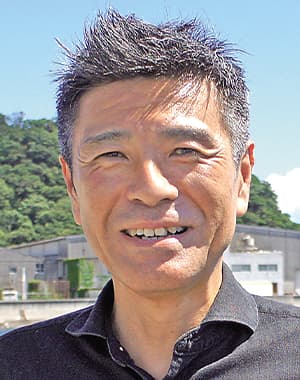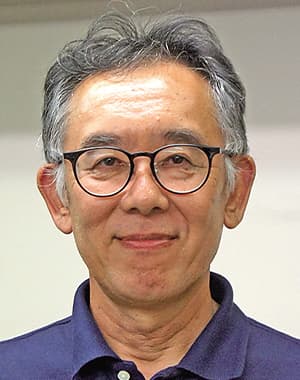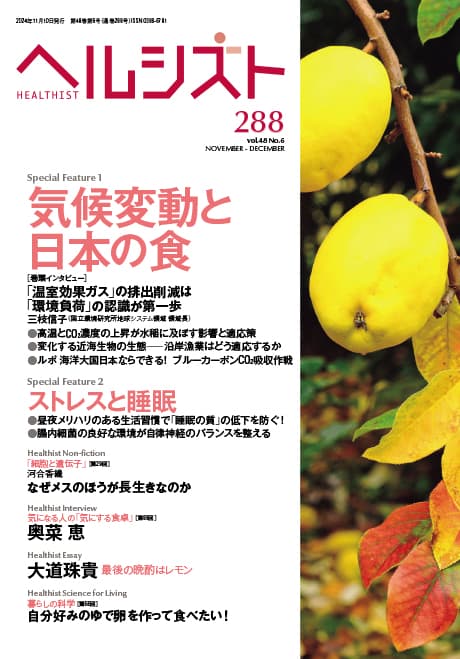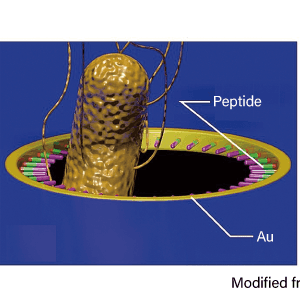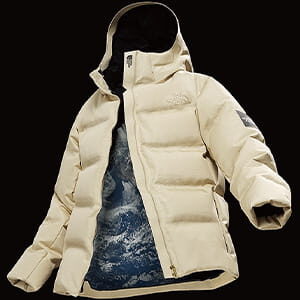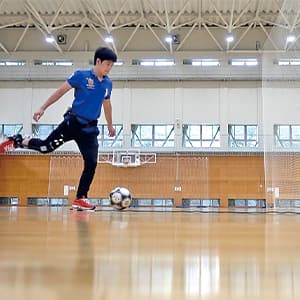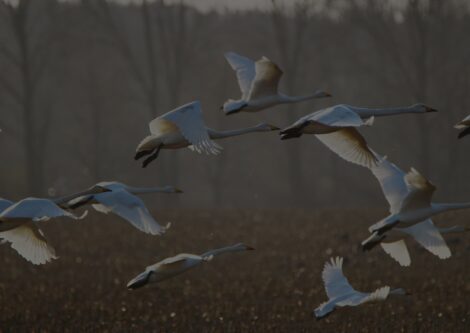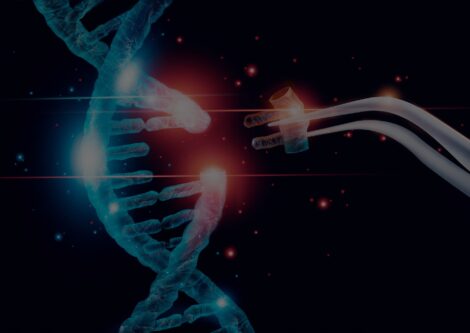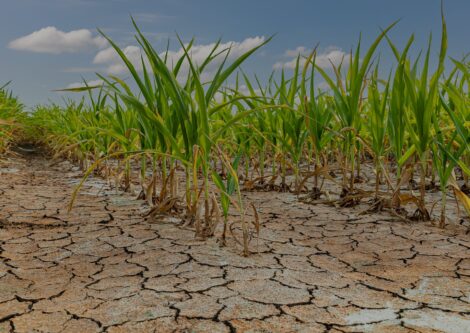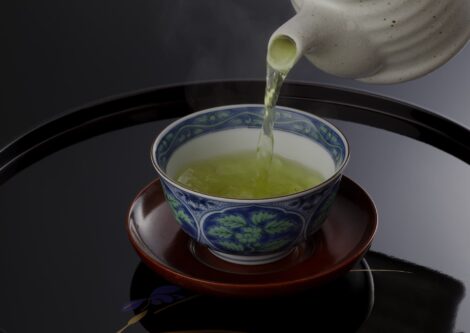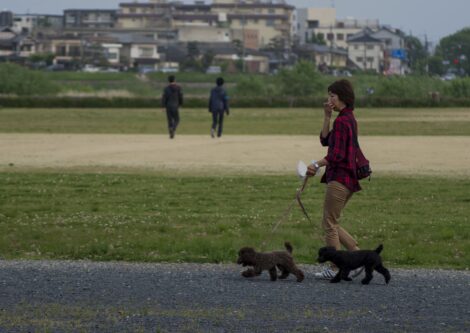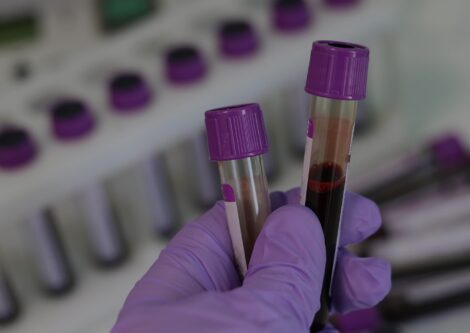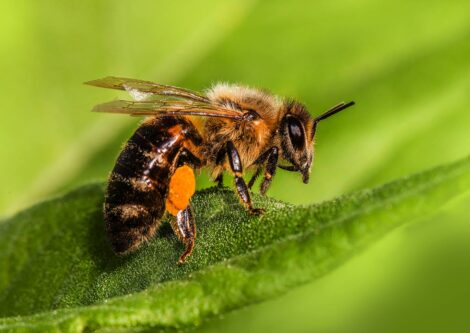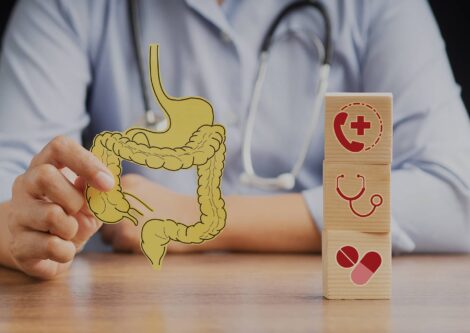Marine forests filled with numerous seaweed species stretch along the Japanese coast. Known in Japan as the “cradle of the sea,” for the role they play in nurturing fish and shellfish, these beds of marine plants have now become the focus of attention as blue carbon ecosystems capable of absorbing and storing atmospheric CO2. One project currently underway aims to tap into blue carbon ecosystems as CO2 sinks, while also furthering the development of the fisheries industry. Hopes are growing that this measure to tackle global warming will succeed in Japan, given the nation’s culinary culture of eating seaweed and abundant scientific knowledge of these marine plants.
Special Feature 1 – Climate Change and Japanese Food Special Report
Japan can make blue carbon a realistic strategy
text by Rie Iizuka
Countries around the world are endeavoring to reduce greenhouse gases (GHGs) as a means to combat global warming. Japan has set a target of achieving a 46% reduction in GHGs against 2013 levels by FY2030, in order to attain carbon neutrality by 2050. Total GHG emissions in FY2022 amounted to approximately 1.135 billion tons, representing a 19.3% reduction from FY2013. It would be fair to say that this reduction is the result of efforts to curb the generation of GHGs, particularly CO2, by cutting back on the use of fossil fuels, which emit high levels of CO2, and using renewable alternative energy sources in the form of solar, wind, hydro, geothermal, and biomass energy.
- *1 Carbon neutrality: A situation in which the volume of GHGs emitted is equal to the volume of GHGs absorbed, thereby effectively achieving zero emissions.
- *2 Biomass: Non-fossil, renewable biologically derived organic resources, such as livestock feces, food waste, and agricultural residues.
The potential of blue carbon
Nevertheless, we also need to consider measures to absorb any unavoidably generated CO2. This is because the oceans and forests in the natural world that have previously absorbed CO2 are no longer sufficient to do so alone.
In Japan, the volume absorbed by forests is falling. Although trees absorb CO2 in the course of their growth, the trees in Japan’s forests —— particularly its planted forests —— are now aging, so the volume of CO2 absorbed has been declining year on year since peaking in 2000 or thereabouts, even though the total area of forest has not changed. Forests make up 67% of Japan’s total land area, which is one of the highest figures among developed countries, but the volume of CO2 absorbed is set to fall if the situation is left unaddressed.
Amid these circumstances, blue carbon is currently attracting attention. Japan Blue Economy Association (JBE) President Tomohiro Kuwae has been quick to focus on the potential of blue carbon and is working on a plan for its implementation as a new means of absorbing CO2.
“Blue carbon refers to carbon that’s taken up by marine ecosystems and stored for long periods in the ocean,” Kuwae explains (Figure 1). “The term was first used in a 2009 report by the UN Environment Programme, in contrast to green carbon, which is carbon taken up by forest ecosystems on land.”
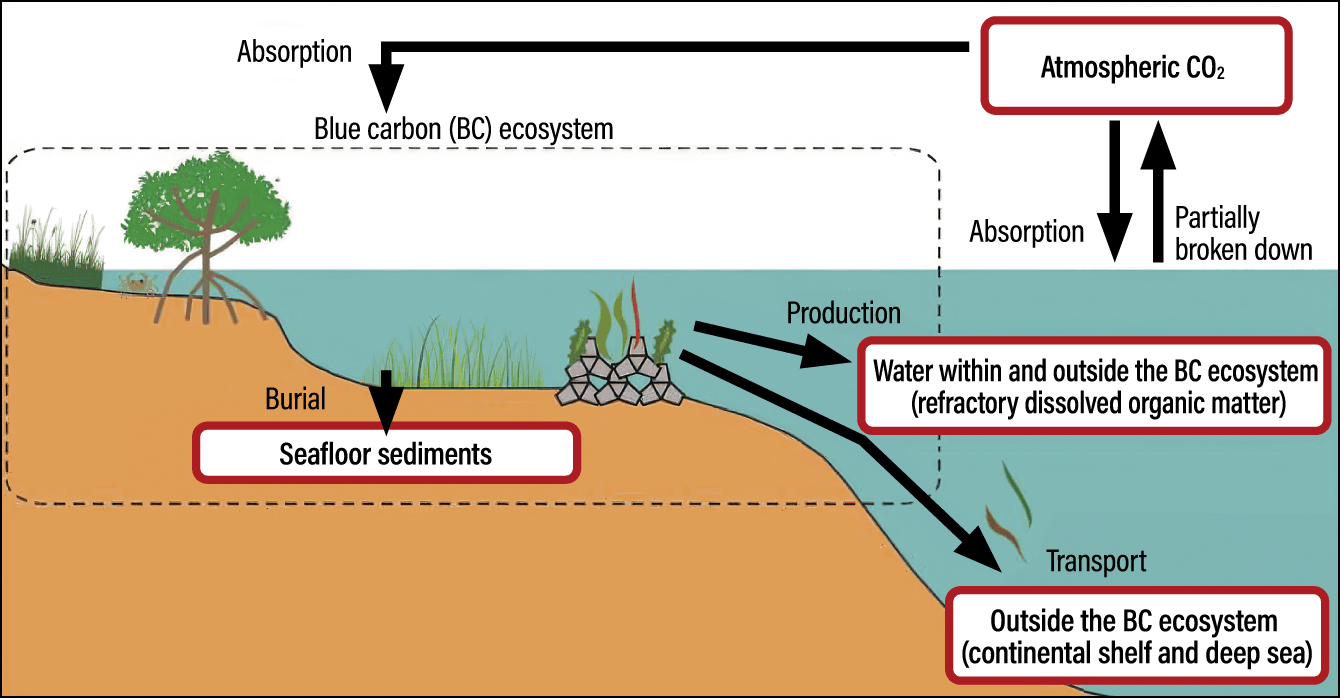 Modified from Kuwae, T. et al. Journal of JSCE, 75: 10–20, 2019.
Modified from Kuwae, T. et al. Journal of JSCE, 75: 10–20, 2019.
Figure 1. The three locations in which organic matter derived from atmospheric CO2 is storedThis is the basic structure of a blue carbon ecosystem. Organic matter derived from atmospheric CO2 is stored for long periods, due to the deposition of organic matter produced by organisms in the marine surface layer, production as refractory dissolved organic matter, and deposition on the continental shelf and in the deep sea.
“Examples of blue carbon ecosystems that absorb CO2 include seagrass meadows, seaweed beds, wetlands, tidal flats, and mangroves,” he continues. “Organic matter derived from atmospheric CO2 (CO2 in the air; all references to CO2 hereinafter indicate atmospheric CO2, unless otherwise specified) builds up in plants in marine ecosystems. After these plants die, the organic matter is deposited in sediment on the seabed, or produces and releases refractory organic substances, or is deposited on the continental shelf or in the deep sea. As blue carbon ecosystems retain CO2-derived organic matter for periods of several hundred to several thousand years, they’ve come to be recognized as very important locations from the perspective of measures to combat global warming.”
- *3 Seagrass and seaweed: Seagrasses are seed plants that grow in the sea, such as common dwarf eelgrass. Seaweeds are algae that live in the sea, such as kelp.
Japan is leading the world in blue carbon initiatives. A 2024 report to the UN not only put a figure on the volume of CO2 absorbed by mangroves, but also provided the world’s first calculation of the volume absorbed by seagrass meadows and seaweed beds. The technology for measuring the volume of CO2 absorption by blue carbon is still developing, but Kuwae has been researching this topic for some time, due to his interest in carbon circulation in marine forests and other shallow coastal ecosystems.
The culinary culture of eating seaweed made research possible
“In 2019, I provided Japan’s first estimate of the volume of CO2 absorbed by blue carbon ecosystems including marine forests, calculating it at 1.32 million tons,” Kuwae says (Figure 2). “I believe it’s Japan’s culinary culture of eating seaweed that’s made this kind of research possible. Japan is surrounded by sea and seaweed such as the kelps wakame and kombu, and nori laver have been eaten and even farmed here for centuries. Due to the development of selective breeding techniques to increase yield and knowledge of the cultivation environment amassed over this time, hardly any other regions have as high a level of scientific knowledge concerning marine forests and seaweed as Japan. I think this culture has led to blue carbon.”
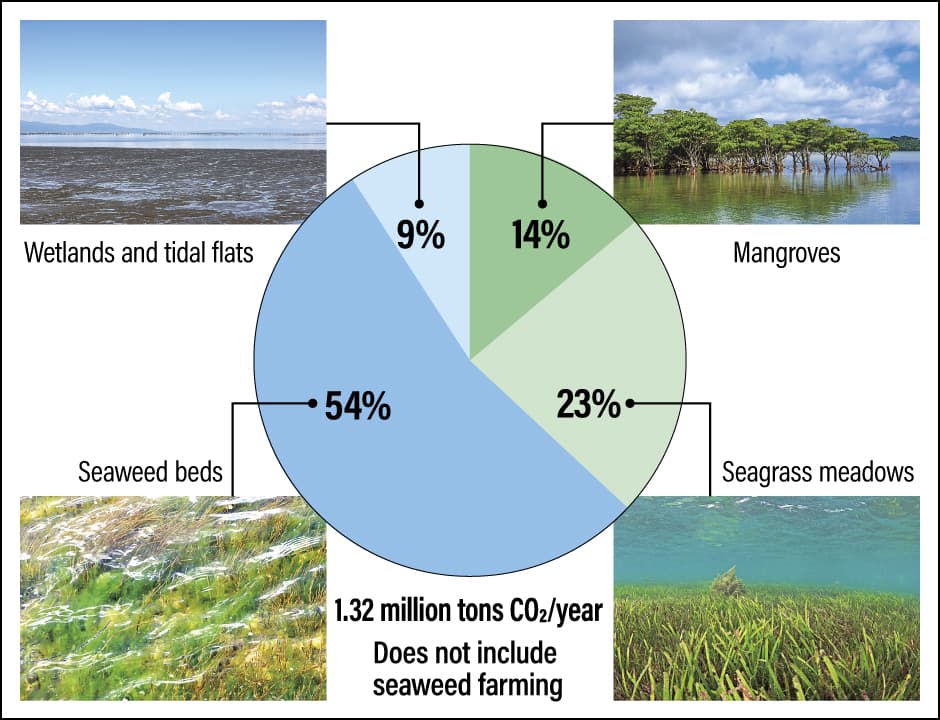 Kuwae, T. et al. Journal of JSCE, 75: 10–20, 2019.
Kuwae, T. et al. Journal of JSCE, 75: 10–20, 2019.
Figure 2. Volume of CO2 absorption by blue carbon ecosystemsSeaweed beds and seagrass meadows together account for 77% of the CO2 absorbed by Japan’s blue carbon ecosystems.
However, the marine plant beds that constitute Japan’s core blue carbon ecosystems face a harsh environment right now. Kuwae calculated the figures in his 2019 article from data measured between 2000 and 2010.
As seaweed beds account for around 77% of Japan’s blue carbon CO2 absorption, the volume they absorbed back then can be calculated at around 1 million tons. However, the figure submitted to the UN in April 2024, which was the actual figure for 2022, was just 350,000 tons —— around one-third of Kuwae’s estimate. While interest in blue carbon ecosystems is growing and Japan is at the head of the pack, the marine forests that are central to CO2 absorption are actually becoming unable to fulfill this function, he says.
“One major factor is the rise in sea temperatures, which is causing a phenomenon called rocky shore denudation. This is said to be due to a large meander in the Kuroshio Current that flows north from the seas to the south of Japan. Rocky shore denudation has also occurred in the past, but it has previously been a short-term phenomenon confined to a limited area. The most recent event has been observed along the Japanese coast for the last seven years and has affected marine plant beds across the country.”
Rocky shore denudation of marine forests has a severe impact on the fisheries industry. Fundamentally speaking, seaweed species prefer lower water temperatures, but the water in the Kuroshio Current is very warm, hindering seaweed growth. In addition, the Kuroshio Current is oligotrophic (low in nutrients), so seaweed does not grow in its waters, and is home to sea urchins unsuited to culinary use and to highly active fish that consume large quantities of seaweed, rendering the algae vulnerable to predation. As the water temperature does not fall even in winter, the fish remain active and consequently there is no letup in this pest damage. Thus, seaweed species in marine forests face multiple overlapping harsh conditions. Kuwae says that fishers across Japan have therefore embarked on proactive efforts to regenerate seaweed beds. The factors contributing to the failure of seaweed beds differ from one region to another, he explains, but recovery has been achieved by such means as thoroughly eradicating sea urchins and fish, and using fertilizers.
Initiatives leading to the revitalization of local communities
These initiatives started out as activities aimed at protecting specialty foods that have become local brands, namely kombu, nori, and sea urchin roe. Then the concept of blue carbon emerged, adding fresh significance to the activities.
“In FY2020, we at JBE created the J-Blue Credit scheme, under which we certify credits for the volume of CO2 absorbed by seaweed beds and other blue carbon ecosystems, and provide a mechanism for companies and organizations implementing measures to combat CO2 to trade in credits for the volume absorbed,” Kuwae says.
“Applications for J-Blue Credits are made on a project basis; applicants report such details as the type of ecosystem (such as a seaweed bed or tidal flat), the volume of CO2 absorbed, and the calculation formula, and the projects are certified and registered after a screening process. So far, 41 projects have been certified nationwide. For fishers, the scheme makes it possible to obtain J-Blue Credits, while enhancing the shallow coastal fishery industry that has been pursued for centuries. They can also use it as a new source of funding for local blue carbon ecosystem conservation activities, such as efforts to expand the area of seaweed beds regenerated. The application requires a bit more effort on their part, measuring the size of the seaweed and photographing it, but the fishers team up with local government and research institutions and the like, and these initiatives even seem to be leading to the revitalization of local communities.”
Inspired by projects registered for J-Blue credits, efforts to make use of underwater forests in various areas also began to attract attention. One example in Chiba Prefecture is a plan for a project to use a Japanese dwarf eelgrass (Zostera japonica) meadow on Banzu tidal flat in Kisarazu City to cultivate Manila clams (Ruditapes philippinarum) that qualify for the designation “Edomae,” indicating their origin in Tokyo Bay.
According to Mitsuhiro Ishii of Chiba Prefectural Fisheries Research Center, “Catches of Manila clams are plummeting nationwide. And Tokyo Bay is no exception to this. Factors cited as root causes of the poor catches include a lack of food due to a decline in phytoplankton and predation by birds and the like. In Tokyo Bay, falling nutrient levels in seawater are another reason for the decrease in phytoplankton. Fishers have sought to prevent avian predation by installing net enclosures and covers, but doing so imposes a major burden on them, as well as limiting the range within which they can operate (Figure 3-① and ②). We wondered whether we could use Japanese dwarf eelgrass meadows to resolve this situation.”
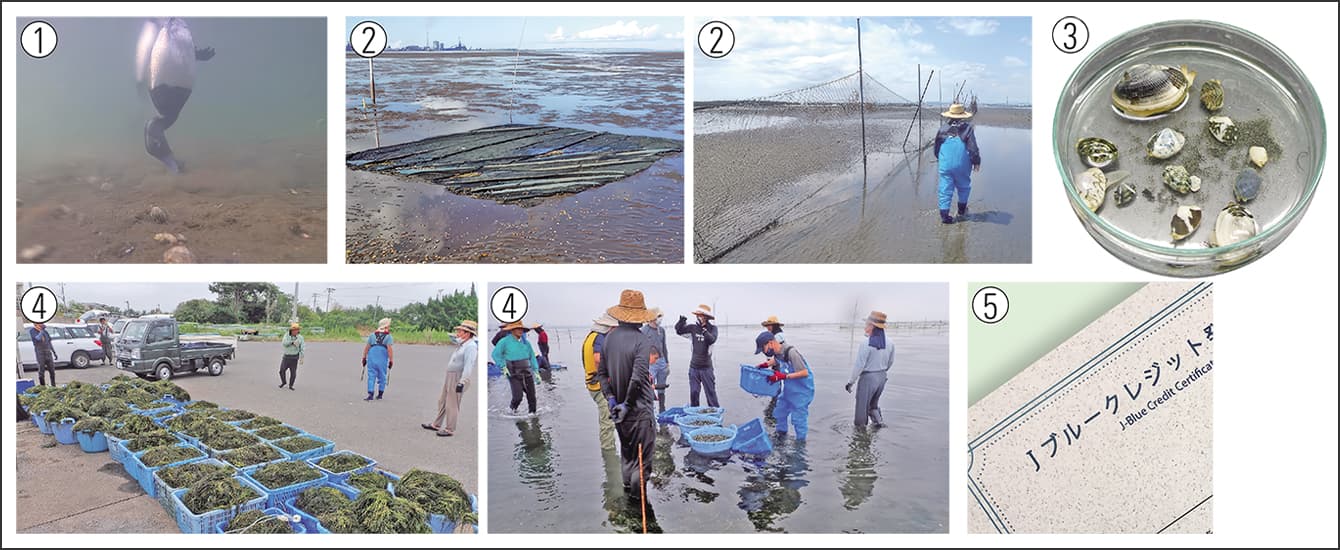 This study was supported financially by project JPJ008722 commissioned by the Ministry of Agriculture, Forestry and Fisheries of Japan. (Photographs ①②④ courtesy of Chiba Prefectural Fisheries Research Center; photograph ⑤ courtesy of JBE)
This study was supported financially by project JPJ008722 commissioned by the Ministry of Agriculture, Forestry and Fisheries of Japan. (Photographs ①②④ courtesy of Chiba Prefectural Fisheries Research Center; photograph ⑤ courtesy of JBE)
Figure 3. Japanese dwarf eelgrass helps to nurture Tokyo Bay’s Manila clams and absorb CO2① Birds can easily find the clams in clear seawater.
② Net enclosures and covers to prevent predation.
③ Large and small Manila clams found amid the Japanese dwarf eelgrass. A distinctive feature of Tokyo Bay’s Manila clams is their diversity of color and pattern.
④ In collaboration with fishers and other locals who offered their cooperation, the team thinned the Japanese dwarf eelgrass and harvested the Manila clam juveniles.
⑤ Paper manufactured with a Japanese dwarf eelgrass content of 1%. The harvested dwarf eelgrass was dried and mixed with the paper. J-Blue Credit certificates are also printed on this paper. If this kind of recycling to reuse the thinned Japanese dwarf eelgrass becomes established, it will contribute to the fixation of CO2.
“Japanese dwarf eelgrass is not, strictly speaking, a seaweed, but rather a seed plant (spermatophyte, also known as a phanerogam) that forms meadows in shallow waters. Banzu tidal flat is currently the largest common eelgrass (Zostera marina) and Japanese dwarf eelgrass habitat in Tokyo Bay. But this dwarf eelgrass was regarded by fishers as a nuisance and they sometimes even removed it, because they couldn’t gather clams in places where the dwarf eelgrass had formed clumps, or because the dwarf eelgrass got tangled up in the nori, reducing its quality,” Ishii explains.
“However, as Japanese dwarf eelgrass roots are very dense, shellfish juveniles are prone to cluster among its clumps, making it harder for birds to eat them. As Japanese dwarf eelgrass also provides a habitat for plankton and microalgae, and becomes a source of nutrients when it dies, it appeared to be a place where organic material accumulates.”
Informed by the fishers that there were Manila clams under the Japanese dwarf eelgrass, Ishii found that their words stuck in his head. He changed track and thought about whether they could make good use of the dwarf eelgrass.
“When I investigated, I found there were indeed lots of Manila clams in places with clumps of Japanese dwarf eelgrass,” Ishii says (Figure 3-③). “Environmentally speaking, too, my results showed that the soil where Japanese dwarf eelgrass grows contains a great deal of organic matter, and is high in nitrogen and phosphorus nutrient salts. Fertilizing tidal flats also provides abundant food for Manila clams. The rhizomes of Japanese dwarf eelgrass prevent the juveniles from being washed away by the waves, which means that Manila clams gather there. Taking advantage of this environment, the fishers cultivate Manila clams in the dwarf eelgrass meadows, then thin out the Japanese dwarf eelgrass, collect the juveniles clinging to it, release the juveniles in their existing net enclosures, and harvest the clams in due course. In addition, we think we might be able to create a cycle that incorporates CO2 fixation by using the thinned dwarf eelgrass as an industrial product.”
Around 50 million tons are absorbed by the sea
In a two-year pilot trial conducted in a test location with an area of 1,200 m2, those involved in the study harvested 57 kg of juveniles from the place where the Japanese dwarf eelgrass had been thinned in the first year, and 423 kg of Manila clams (including both juveniles and mature shellfish) in the second year (Figure 3-④). The 720 kg or so of Japanese dwarf eelgrass thinned per year is used as a raw material in making paper, with the cooperation of a paper manufacturer (Figure 3-⑤). An application for J-Blue Credit certification is also under consideration.
“I’m keen to promote this initiative from the perspective of increasing the number of Manila clams in Tokyo Bay, while also achieving the absorption of CO2 via the reuse of the thinned Japanese dwarf eelgrass,” Ishii explains.
Although efforts to regenerate coastal marine forests to absorb CO2 are progressing in various areas, it will be difficult for Japan to achieve its reduction targets through those initiatives alone. Accordingly, JBE is considering a geoengineering project involving the large-scale offshore production of seagrass and seaweed, for the purpose of CO2 absorption and fixation.
On the subject of initiatives focused on a carbon-neutral future, Kuwae has this to say: “The harsher forecasts suggest we’ll only be around 80% of the way to achieving carbon neutrality by 2050. It’s a very rough calculation, but if we assume that 20% of the approximately 1.1 billion tons of emissions won’t be able to be absorbed, we’ll have to think of some kind of way of removing around 200 million tons of CO2. In Japan, forests play the central role in absorbing CO2 in the natural world, and while they currently absorb about 50 million tons, some projections suggest this figure will fall to 30 million tons by 2030. In addition to CCS and the regeneration of marine forests, I think it will be essential to adopt drastic measures, including using the sea to absorb around 50 million tons.”
- *4 CCS: Carbon dioxide Capture and Storage. A method of CO2 fixation that involves gathering CO2 emitted from power plants, factories, and the like, and injecting it deep underground for storage.
“Accordingly, we’re considering large-scale offshore seaweed farming,” he continues (Figure 4). “We can implement the long-term storage of CO2-derived organic matter by breeding seaweed that grows quickly and absorbs a lot of CO2, then growing it offshore and burying it on the seafloor. I believe the conditions for this project are in place, given that Japan has the world’s sixth-largest exclusive economic zone, and that many parts of the Japan Trench are 1,000 m or more deep. Technically speaking, calculations suggest that as much as 50 million tons per year can be absorbed, so we’re currently engaged in deliberations with companies and government authorities, among others.”
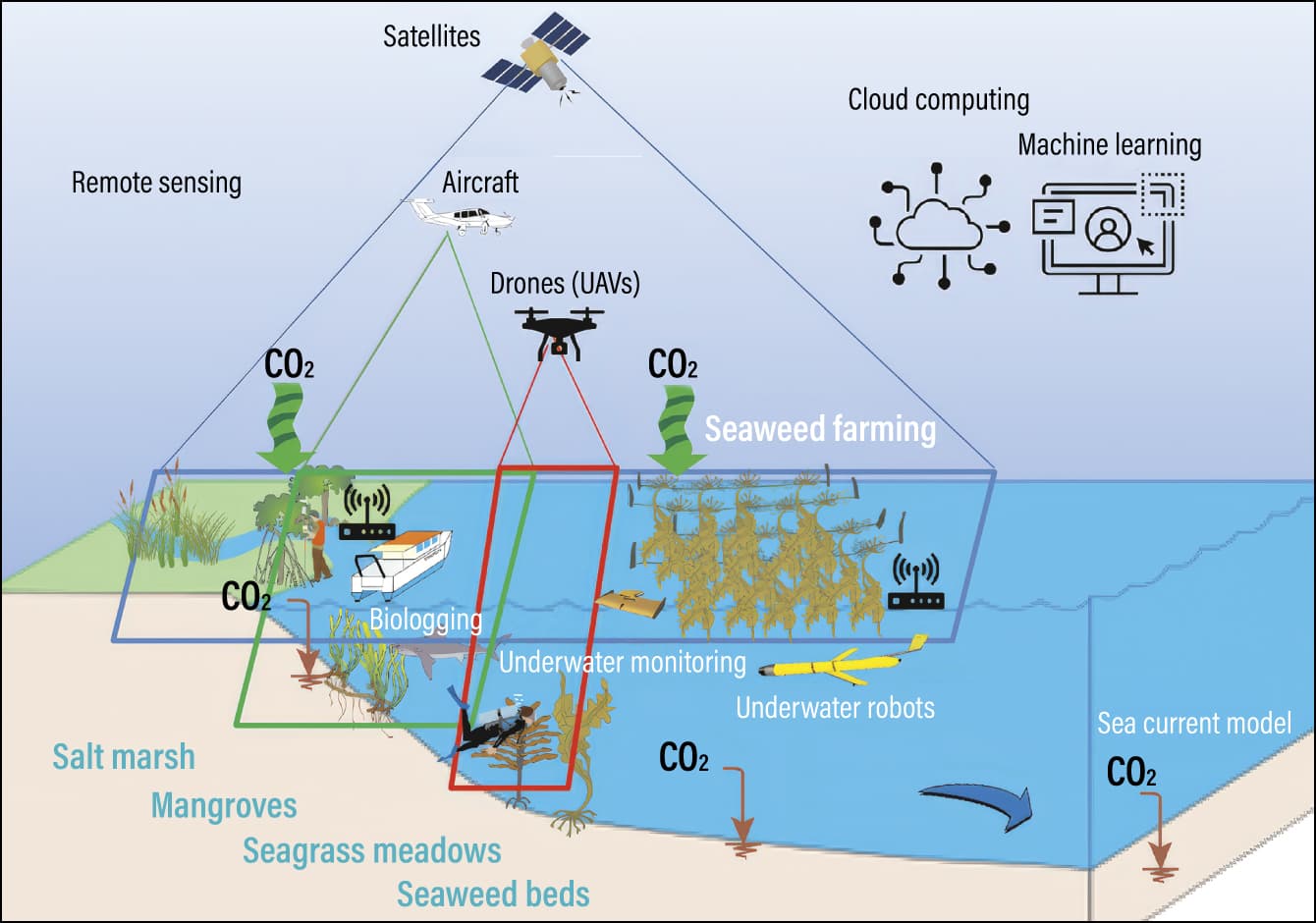 Modified from Watanabe, et al. Blue Carbon Roadmap. ICEF, 2023.
Modified from Watanabe, et al. Blue Carbon Roadmap. ICEF, 2023.
Figure 4. Blue carbon roadmapIn addition to conventional blue carbon ecosystems, such as salt marshes, seagrass meadows, and seaweed beds, large-scale farming of seaweed designed specially for absorbing CO2 will take place offshore. These will be managed using cutting-edge technology, in the form of drones and remote sensing.
“I want to make effective use of blue carbon ecosystems for absorbing and reducing GHGs by means of a two-pronged approach: having fishers and local citizens regenerate seaweed beds as food production sites, as well as conducting activities while earning credits; and establishing large-scale offshore seaweed farming.”
As global interest in blue carbon ecosystems is high, JBE receives various inquiries from around the world. Hopes are growing for global warming countermeasures originating in the seaweed beds that play such a crucial role in Japanese culinary culture.


